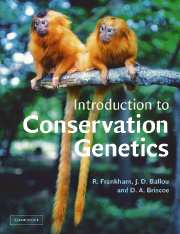Book contents
- Frontmatter
- Contents
- Preface
- Copyright acknowledgments
- Chapter 1 Introduction
- Chapter 2 Genetics and extinction
- SECTION I EVOLUTIONARY GENETICS OF NATURAL POPULATIONS
- SECTION II EFFECTS OF POPULATION SIZE REDUCTION
- SECTION III FROM THEORY TO PRACTICE
- Take home messages from this book
- Revision problems
- Glossary
- Answers to problems
- References
- Index
SECTION III - FROM THEORY TO PRACTICE
Published online by Cambridge University Press: 05 June 2012
- Frontmatter
- Contents
- Preface
- Copyright acknowledgments
- Chapter 1 Introduction
- Chapter 2 Genetics and extinction
- SECTION I EVOLUTIONARY GENETICS OF NATURAL POPULATIONS
- SECTION II EFFECTS OF POPULATION SIZE REDUCTION
- SECTION III FROM THEORY TO PRACTICE
- Take home messages from this book
- Revision problems
- Glossary
- Answers to problems
- References
- Index
Summary
In Sections I and II we covered the evolutionary genetics of populations and the deleterious genetic consequences of population size reduction. In Section III we apply this information to the genetic management of threatened populations and species.
Taxonomic uncertainties and management units
A critical first step in conserving a species is to gain a clear understanding of its taxonomy. Is the population of interest a unique species? Does it actually consist of multiple cryptic species? Or is it simply another population of a common species? Without this knowledge endangered species may be denied protection, or resources wasted on populations of common species. The use of genetic techniques to assist in resolving taxonomic uncertainties is described in Chapter 15. To do this we must first define what is meant by a species and consider briefly how speciation occurs. Populations within species may be so distinct that crosses suffer reduced reproductive fitness (outbreeding depression). Consequently, they may require management as separate entities. The chapter concludes by considering means for defining management units within species.
Management of wild populations
The genetic management of wild populations is considered in Chapter 16. Typically wild population management is concerned with increasing population sizes and alleviating the effects of population fragmentation. Species with inadequate gene flow among population fragments will suffer an insidious process of inbreeding depression, loss of genetic diversity and eventually population extinctions, unless gene flow is reestablished. Sadly, there is limited activity in this area.
- Type
- Chapter
- Information
- Introduction to Conservation Genetics , pp. 361 - 364Publisher: Cambridge University PressPrint publication year: 2002



